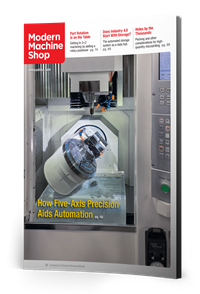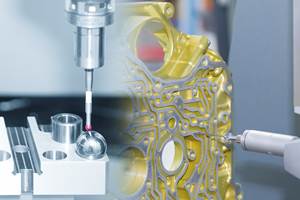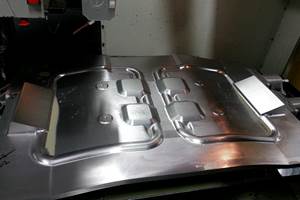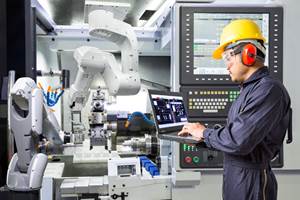Automating Surface Metrology for the Shop Floor
Machine operators are likely to get improved results when the surface finish gage is smart enough to choose the best measuring parameters.
Share



Autodesk, Inc.
Featured Content
View More





ECi Software Solutions, Inc.
Featured Content
View MoreWe have come a long way from the not-so-distant past in which surface finish was “measured” by judgment or compared to a standard with a fingernail. Since the inception of roughness metrology, the number of international standards and internationally recognized surface parameters has continually increased. This fact makes it particularly difficult for new employees in the quality room or in production to grasp an overview, let alone the intricacies of surface metrology.
The basics of measuring a surface have been pretty consistent over the past 60 years or so. The surface measuring instrument moves a precision stylus across a surface and the resulting signal, or trace, is analyzed and presented to the user. What’s different today is that there are a host of new parameters and variations to the instrument that can lead to very different results when different settings of the gage parameters are used.
Take filtering and cutoff lengths, for example. There are three components in the surface texture trace, which are filtered to determine specific surface roughness or waviness characteristics. Depending on what filter settings are used, one can remove the waviness element to evaluate the roughness profile or eliminate the roughness elements to evaluate the waviness profile.
Separating the roughness and waviness elements is done using filter cutoffs. Incorrect choice of cutoff length is one of the main reasons for incorrect surface finish results. The cutoff length must be long enough to provide sufficient data for the measurement, but not so long that part geometry can impose extraneous data. A properly specified cutoff usually includes 10 to 15 tool marks for most machined surfaces.
But cutoff length is not to be confused with stroke or traverse length, which is the total distance the probe travels, and may be 2-, 12- or even 18-inches long (50, 300 and 450 mm) in order to evaluate waviness and straightness. Detailed information about the choice of cutoffs is found in Chapters 3 and 4 of ASME B46.1.
A typical surface finish callout consists of many elements, all of which may be required because of the complexity of surface finish metrology. Under the old ANSI B46.1-1985 standard, a default value of 0.030 inch (0.8 mm) was applied to any surface finish callout that did not specify a cutoff. This is an effective cutoff value for many, but not all, roughness measurements. To avoid confusion and lax specifying, the new ASME B46.1-1995 standard abolishes the default and insists that all cutoffs be specified. It is standard procedure to measure five cutoffs within a single stroke and average the results, although fewer may be used if the surface is too short to include five. Where a manufacturing process is known to be consistent, fewer than five cutoffs may be sufficient to generate reliable results. When reporting results, the number of cutoffs should be indicated if it is not five.
So now our machinist—who is used to part programming and helping to assure the quality of the parts coming off the machine—is somehow supposed to become a semi-expert on surface finish standards and parameters as well. For that machinist, this may be too much to ask.
One solution available now is a feature built into some surface gages for automatic cutoff selection. In effect, the measuring system selects the right filters and correct measuring traverse length. This is done automatically while the part is being measured, depending on the magnitude of the value for the width of profile elements (Rsm) or surface roughness depth (Rz) (as per DIN EN ISO 4288 and ASME B46.1).
Once the measurement is complete, the profile can also be filtered automatically with the most appropriate cutoff length depending on the traverse length. Measurement errors and incorrect filter settings are thus avoided.
Of course, this automatic selection should not be used when the blueprints call for specific cutoff lengths or other trace settings. But for general-purpose surface-finish checks, the use of automatic selections can improve results, and is apt to improve correlation between similarly used systems.
Related Content
Rethink Quality Control to Increase Productivity, Decrease Scrap
Verifying parts is essential to documenting quality, and there are a few best practices that can make the quality control process more efficient.
Read More4 Tips for Staying Profitable in the Face of Change
After more than 40 years in business, this shop has learned how to adapt to stay profitable.
Read More6 Machine Shop Essentials to Stay Competitive
If you want to streamline production and be competitive in the industry, you will need far more than a standard three-axis CNC mill or two-axis CNC lathe and a few measuring tools.
Read More6 Variations That Kill Productivity
The act of qualifying CNC programs is largely related to eliminating variations, which can be a daunting task when you consider how many things can change from one time a job is run to the next.
Read MoreRead Next
5 Rules of Thumb for Buying CNC Machine Tools
Use these tips to carefully plan your machine tool purchases and to avoid regretting your decision later.
Read MoreRegistration Now Open for the Precision Machining Technology Show (PMTS) 2025
The precision machining industry’s premier event returns to Cleveland, OH, April 1-3.
Read MoreBuilding Out a Foundation for Student Machinists
Autodesk and Haas have teamed up to produce an introductory course for students that covers the basics of CAD, CAM and CNC while providing them with a portfolio part.
Read More

















.png;maxWidth=150)


























